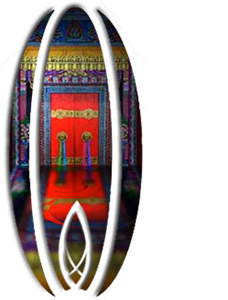Shinto
- At January 10, 2007
- By Betty
- In Mysticism, Religion
 0
0

Shinto is the native religion of Japan and was once its state religion. It involves the worship of kami gods. Some kami are local and can be regarded as the spiritual being/spirit or genius of a particular place, but other ones represent major natural objects and processes: for example, Amaterasu, the Sun goddess, or Mount Fuji. Shinto is an animistic belief system. The word Shinto was created by combining two kanji: (shin), meaning gods or spirits (when read alone, it is pronounced “kami”), and (t?), meaning a philosophical way or path (originally from the Chinese character Tao). As such, Shinto is commonly translated as “the Way of the Gods”.
After World War II, Shinto lost its status as the state religion of Japan; some Shinto practices and teachings, once given a great deal of prominence during the war, are no longer taught or practiced today, and others exist today as commonplace activities such as omikuji (a form of fortune-telling) and Japanese New Year that few give religious connotations. Important national ceremonies such as coronations and royal marriages are conducted at the Three Palace Sanctuaries in Tokyo, and many Japanese still travel at least once in their lives to the Grand Shrine of Ise in Mie Prefecture.
A number of theories exist about the ancestors of today’s Japanese people. Most scholars agree that there was at least one migration from East Asia and perhaps another from Central Asia to the ancient Japanese Archipelago, though there is no consensus as to where Shinto first developed. Some of them claim that it has always existed in Japan, back into the mists of the Jomon age. Others maintain that it came about in the Yayoi period as a cultural product of immigrants from China and the Korean Peninsula, who brought agricultural rites and shamanic ceremonies from the continent, which took on Japanese forms in the new environment. Some modern scholars claim that “Shinto,” as it is presently understood, did not exist in this age at all and should be more properly referred to as ‘kami worship’.
In the early centuries BC, each tribe and area had its own collection of gods with no formal relationship between them. However, following the ascendancy of the Yamato Kingdom around the third to fifth centuries, the ancestral deities of its Emperor of Japan (Imperial family) were given prominence over others and a narrative made up to justify it. The result was the mythologizing of Kojiki (Record of Ancient Matters, 712) in which it was claimed that the imperial line descended directly from the sun-goddess Herself. Another important kingdom, Izumo, was dealt with in a separate cycle within the mythology and its deities incorporated into service of Amaterasu’s descendants. A more objective and historical version of events appeared in Nihon Shoki (The Chronicles of Japan, 720), where alternative versions of the same story are given.
Early ceremonies are thought to have been held outside before copses (Iwakura) or sacred rocks forming a (Himorogi). There was no representation of the kami, for they were conceived as formless and pure. After the arrival of Buddhism in the sixth century, the idea of building ‘houses’ for the kami arose and shrines were built for the first time. The earliest examples are thought to have been at Izumo (659) and Ise (690).
An important development was the introduction of the Ritsuryo System in the late seventh and early eighth centuries, based on the Chinese system. This established in law the supremacy of the emperor and great nobles, as well as formalizing their relationship to major shrines and festivals.
Even before the arrival of Buddhism, the rituals involved in kami worship had borrowed from Chinese Taoism and Confucianism. Though clan rivalry led to friction and fighting during the introduction of Buddhism, the worship of kami and the teachings of the Buddha soon settled into coexistence. In fact, syncretism between Buddhism and Shinto was to become the dominant feature of Japanese religion as a whole.
he introductions of writing in the 5th century and Buddhism in the 6th century had a profound impact on the development of a unified system of Shinto beliefs. In the early Nara period, within a brief period the Kojiki and the Nihon Shoki were written by compiling existing myths and legends into a unified account of stories. These accounts were written with two purposes in mind: the introduction of Taoist, Confucian, and Buddhist themes into Japanese religion, and garnering support for the legitimacy of the Imperial house, based on its lineage from the Sun Goddess Amaterasu. Much of modern Japan was under only fragmentary control by the Imperial family, and rival ethnic groups (including, perhaps, the ancestors of the Ainu people) continued to war against the encroachment of the Japanese. The mythological anthologies, along with other poetry anthologies like the Manyoshu and others, were intended to impress others with the worthiness of the Imperial family and their divine mandate to rule.
With the introduction of Buddhism and its rapid adoption by the court, it was necessary to explain the apparent differences between native Japanese beliefs and Buddhist teachings. Indeed, Shinto did not have a name until it became necessary to distinguish it from Buddhism. One explanation saw the kami as supernatural beings still caught in the cycle of birth and rebirth (reincarnation). The kami are born, live, die, and are reborn like all other beings in the karmic cycle. However, the kami played a special role in protecting Buddhism and allowing its teachings of compassion to flourish. This explanation was later challenged by K?kai, who saw the kami as different embodiments of the Buddhas themselves. For example, he famously linked Amaterasu, Sun Goddess and ancestor of the Imperial family, with Dainichi Nyorai, a central manifestation of the Buddha, whose name is literally “Great Sun Buddha”. In his view, the kami were just Buddhas by another name.
Buddhism and Shinto coexisted and were amalgamated in the shinbutsu sh?g? and K?kai’s syncretic view held wide sway up until the end of the Edo period. At that time, there was a renewed interest in “Japanese studies” (kokugaku), perhaps as a result of the closed country policy. In the 18th century, various Japanese scholars, in particular Motoori Norinaga (1730?1801), tried to tease apart the “real” Shinto from various foreign influences. The attempt was largely unsuccessful; since as early as the Nihon Shoki, parts of the mythology were explicitly borrowed from Chinese doctrines. (For example, the co-creator deities Izanami and Izanagi are linked to yin and yang.) However, the attempt did set the stage for the arrival of state Shinto, following the Meiji Restoration, when Shinto and Buddhism were separated (shinbutsu bunri).
Shinto can be seen as a form of animism and may be regarded as a variant of shamanist religion. Shinto beliefs and ways of thinking are deeply embedded in the subconscious fabric of modern Japanese society. The afterlife is not a primary concern in Shinto; much more emphasis is placed on fitting into this world, instead of preparing for the next.
Shinto has no binding set of dogma, no holiest place for worshippers, no person or kami deemed holiest, and no defined set of prayers. Instead, Shinto is a collection of rituals and methods meant to mediate the relations of living humans and kami. These practices have originated organically in Japan over many centuries and have been influenced by Japan’s contact with the religions of other nations, especially China. Notice, for example, that the word Shinto is itself of Chinese origin and that much of the codification of Shinto mythology was done with the explicit aim of answering Chinese cultural influence. Conversely, Shinto had and continues to have an impact on the practice of other religions within Japan. In particular, one could even make a case for discussing it under the heading of Japanese Buddhism, since these two religions have exercised a profound influence on each other throughout Japanese history. Further, the Japanese “New religions” that have emerged since the end of the Second World War have also shown a clear Shinto influence.
Some feel Shinto was used as a legitimizing ideology during the militaristic phase of Japanese history following the Meiji Restoration. Because Shinto has no absolute source of authority, some feel what was a natural expression of the beliefs of the people was hijacked by radical Nationalists, who desired to unify the Japanese people against the “inferior” people in other nations. Others wonder if the emphasis Shinto places on Japanese exceptionalism made such developments inevitable. Even today, some far right factions within Japanese society want to see a greater emphasis placed on Shinto and increased reverence shown to the Emperor as part of a project to restore Japan to its “rightful place” as the leading nation of the world. For most Japanese, however, Shinto is not about expressing disdain for other nations but expressing one’s own love of the natural landscape of Japan and the people and spirits that reside within it.
Unlike many religions, one does not need to publicly profess belief in Shinto to be a Shintoist. Whenever a child is born in Japan, a local Shinto shrine adds the child’s name to a list kept at the shrine and declares him or her “Ujiko”, literally named child. After death an “Ujiko” becomes an “Ujigami”; literally, named kami. One may choose to have one’s name added to another list when moving and then be listed at both places. Names can be added to the list without consent and regardless of the beliefs of the person added to the list. However, this is not considered an imposition of belief, but a sign of the welcome of the area kami, with the promise of addition to the pantheon of kami after death. Those children who die before addition to the list are called “Mizuko”, literally water children, and believed to cause troubles and plagues. “Mizuko” are often worshipped in a Shinto shrine dedicated to stilling their anger and sadness.
Because Shinto has co-existed with Buddhism for well over a millennium, it is very difficult to untangle Shinto and Buddhist beliefs about the world. One might say that where Buddhism emphasizes the afterlife and ending the cycle of rebirths; Shinto emphasizes this life and finding happiness within it. Though Buddhism and Shinto have very different perspectives on the world, most Japanese do not see any challenge in reconciling these two very different religions, and practice both. Thus it is common for people to practice Shinto in life yet have a Buddhist funeral. Their different perspectives on the afterlife are seen as complementing each other, and frequently the ritual practice of one will have an origin in the other.

